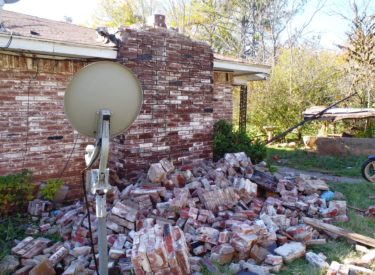How an Oklahoma Earthquake Showed Danger Remains After Years of Quakes Becoming Less Frequent
Associated Press - February 8, 2024 6:31 am

2011 Oklahoma earthquake damage.
OKLAHOMA CITY (AP) — After a dramatic spike in earthquakes in the early 2010s, state regulators in Oklahoma began taking steps to limit the injection of wastewater from oil and gas extraction deep into the ground. As a result, the number of earthquakes, particularly large ones, declined steadily over the years.
But a couple of larger quakes in recent weeks, including a 5.1-magnitude temblor over the weekend that was one of the strongest in years, is a reminder of the danger after the last one shook an area dotted with such injection wells.
The quake would be tied as the fourth-strongest in Oklahoma history if seismologists maintain the rating, according to Oklahoma Geological Survey data.
Here’s the latest on what’s happening in Oklahoma.
WHAT’S CAUSING THE OKLAHOMA QUAKES?
The wastewater is left over from oil and natural gas production, which includes saltwater, drilling fluids and other mineralized water, thousands of feet (meters) into the ground. The earthquake late Friday night, which shook an area near Oklahoma City, was in a patch that had nine disposal wells within a ten-mile (16-kilometer) radius, although not all of those wells were active.
“The problem is because you’re talking about many areas injecting fluids, and many faults,” Hayman said. “It’s very difficult when there’s an earthquake to know exactly what caused it.”
WHAT HAS OKLAHOMA DONE TO STOP THEM?
The large increase in quakes more than a decade ago led state regulators to place restrictions on the disposal of wastewater, particularly in areas around the epicenter of quakes. Since then, the number of quakes began to decline dramatically.
Generally, earthquakes between magnitude 2.5 to 5.4 can be felt but only cause minor damage, while earthquakes between 5.5 to 6.0 can cause slight damage to buildings. In Oklahoma, the number of earthquakes in the last decade with a magnitude greater than 2.7 dropped from nearly 2,000 in 2015 to less than 40 last year, according to Oklahoma Geological Survey data.
WHERE WERE THE RECENT QUAKES?
At least six earthquakes, including two with a magnitude greater than 4, were recorded in mid-January near the Oklahoma City suburb of Edmond. Then, shortly before midnight on Friday, a 5.1-magnitude quake struck that was centered about 5 miles (8 kilometers) northwest of Prague, Oklahoma, the Oklahoma Geological Survey reported.
Following that quake, the Oklahoma Corporation Commission ordered all disposal wells pumping into the Arbuckle formation, a deep layer of rock under the earth’s surface, within 10 miles (16 kilometers) of the epicenter of the quake to begin slowly reducing disposals. The gradual reduction is necessary to avoid sudden pressure changes that could result in more seismic activity, said spokesperson Matt Skinner, whose agency regulates the oil and gas industry in Oklahoma.
In the 30 days before the quake, Skinner said nearby operators were disposing of a total of 10,000 barrels of wastewater per day at six active disposal wells, an amount that Skinner said is not abnormally high. By comparison, before the spate of earthquakes in the 2010s, some wells were routinely pumping 50,000 barrels of wastewater or more each day into the formation, he said.
WHAT KIND OF DAMAGE ARE THE QUAKES CAUSING?
In Prague, a small town of about 2,300 residents known for its annual Kolache festival, city manager Jim Greff said the preliminary damage was mostly bricks falling from the exterior of homes, broken glassware and dishes, cracks in sheetrock and cabinet doors thrown open. There were no reports of injuries.
“Some people had chimney damage near the epicenter,” Greff said. “It was mainly just things falling off shelves.”
Tim Holik, who runs an auto repair shop in Praque, said he noticed his fireplace separating from the wall inside the house.
“We almost let our earthquake insurance lapse because we haven’t had one in a while,” Holik said.
HOW BIG WERE OKLAHOMA’S STRONGEST QUAKES?
The strongest recorded earthquake in Oklahoma was a 5.8-magnitude quake near the town of Pawnee in 2016. Some reported feeling the quake as far away as Illinois and southern Texas. After that temblor, a state of emergency was declared and regulators ordered wastewater-disposal wells within a 500-mile (800-kilometer) radius of the epicenter to shut down. No major injuries were reported, but one man was treated and released from the hospital after part of a fireplace fell on him.
Hayman, the OGS scientist, said while it’s impossible to accurately predict earthquakes, he doesn’t believe Oklahoma is at high risk for a major destructive earthquake above a 6.0 magnitude.
“The faults we’re seeing don’t seem to be prone to that magnitude 6 and up where you really start seeing major damage,” he said. “We know scientifically we’re not sitting in the (California) Bay Area waiting for the big one.”



